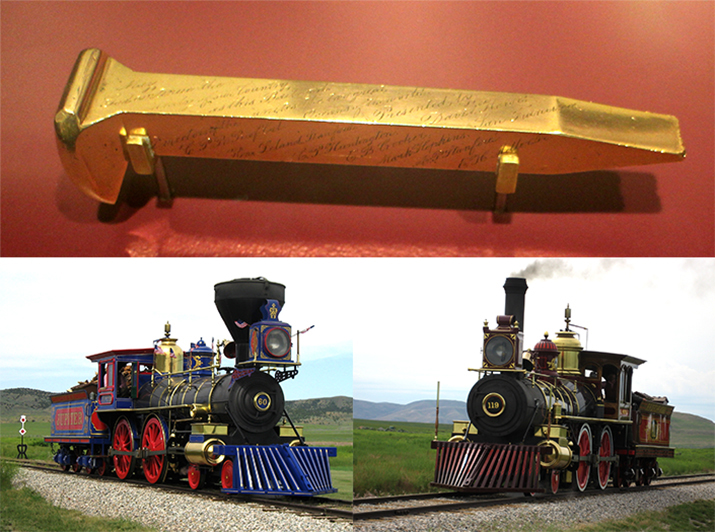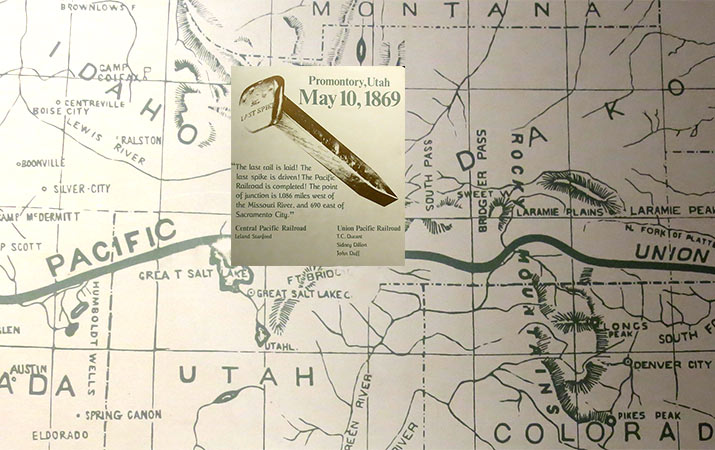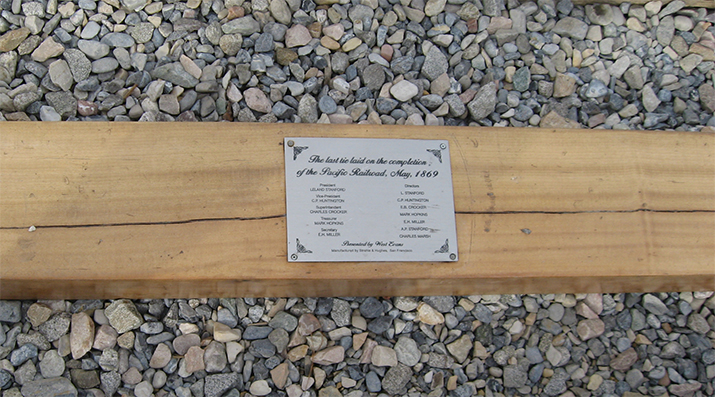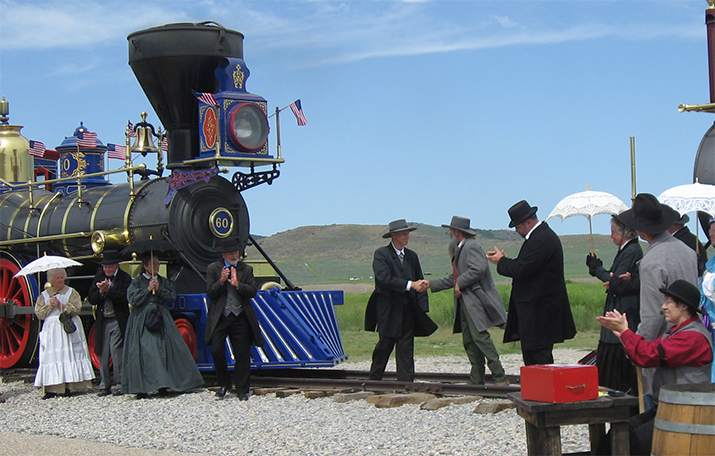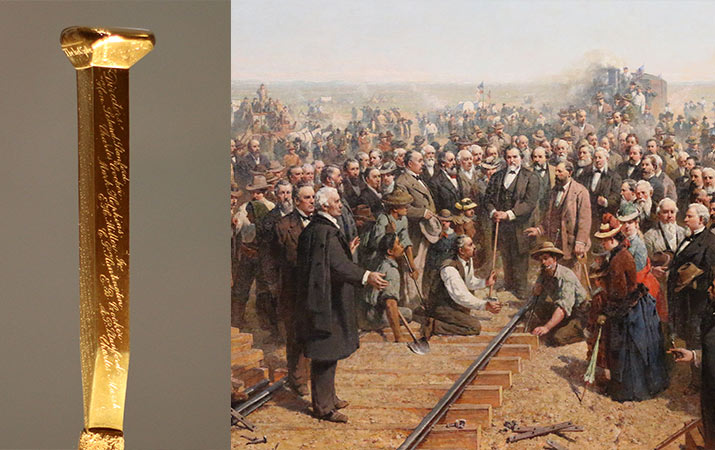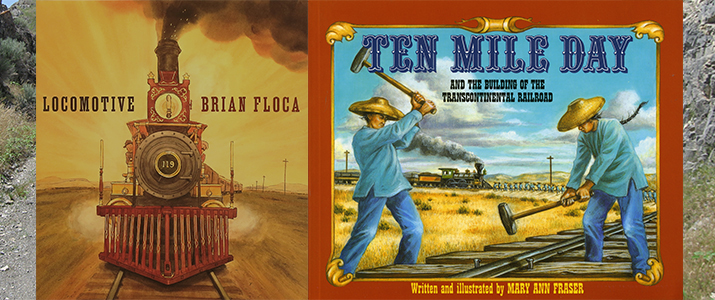On May 10, 1869, the transcontinental railroad was completed at Promontory Summit in Utah, connecting the United States from coast to coast.
Celebrating this historic event, four special spikes were tapped in a railroad tie – the last spike was almost solid gold. Turns out, there was more than one golden “Last Spike.” Years later a second original Last Spike appeared – it was the “Lost Spike.”
Promontory Summit
Six years before, in 1863, the Central Pacific railroad company started building track from Sacramento going east; the Union Pacific company started in Omaha Nebraska and laid track going west.
It was quite a competition between the two companies, but the tracks were finally joined together at Promontory Summit.
The railroad company presidents and other bigwigs gathered on May 10th for a ceremony on the tracks. Each company sent a special train to celebrate the event – Jupiter from the Central Pacific, No. 119 from the Union Pacific. Arriving from east and west, the two trains chugged up the track.
Track workers laid down the final pair of rail tracks in the center.
After speeches, one by one, four commemorative spikes were tapped (not pounded like regular spikes) into a fancy polished railroad tie.
The first spike was iron, silver and gold, the second Nevada silver, the third a (less) gold spike, the Last Spike was three-quarters solid gold.
The Last Spike (Golden Spike) is inscribed with the words “The Last Spike” on the end. The spike has the names of Central Pacific officers, the words “The Pacific Railroad – Ground broken Jany 8th 1863, completed May 8th 1869,” and “May God continue the unity of our Country as the Railroad unites the two great Oceans of the world. Presented by David Hewes San Francisco.”
Golden Spike National Historic Site
When you visit the Golden Spike National Historic Site, from May 1 to Labor Day kids can see exact replicas of the Jupiter and 119 locomotives chugging down the track, On Saturdays are re-enactments of the ceremony with people in period clothing.
The museum has excellent exhibits about building the transcontinental railroad, and a replica of Last Spike.
During our visit to Golden Spike National Historic Site, we took a hike down the Big Fill Trail. It’s a short section where it took two months for 500 laborers to fill a huge gully with dirt for the rails. Imagine laying 1,700+ miles of track across the continent through snowy mountains, forbidding desert wilderness, and every iron spike and rail had to be transported to the work site, without a railroad.
Last Spike
So where is the original Last Spike(s)?
Leland Stanford was one of the directors of the Central Pacific Railroad. Stanford’s brother-in-law David Hewes provided the Last Spike for the ceremony at Promontory Summit. Years later, it was discovered Hewes also ordered a second, identical golden Last Spike, now called the “Lost Spike.”
The “Lost Spike” golden spike is on display in the excellent California State Railroad Museum in Old Sacramento. Find the Lost Spike, along with the “Last Spike” painting (above), just behind the big black Southern Pacific cab-forward locomotive in the museum.
Leland Stanford donated his golden Last Spike and Nevada silver spike to the Stanford Museum in 1898. Visit the Cantor Arts Center, on the campus of Stanford University, California, to see both gold and silver spikes. (Photo at top of the post is golden spike at Cantor Arts Center.)
Children’s Books
Books to read about building the transcontinental railroad:
- Ten Mile Day by Mary Ann Fraser. After six years, Promontory Summit is close, and the Irish and Chinese are a precision work force, laying the iron track, bolting it together, nailing the spikes. The bet is on – can the crew of the Central Pacific lay ten miles of track in one day? (Picture book)
- Until the Last Spike: The Journal of Sean Sullivan by William Durbin. Teenage Sean Sullivan joins his father to work on the Union Pacific railroad, starting in Nebraska and going west. Sean starts out as a water carrier, works as dish swabber, bridge builder, grading crew, and finally spiker. The work gets even harder as competition between the Union Pacific and Central Pacific heats up. (Chapter book)
- Coolies by Yin, Chris Soentpiet. Gorgeously illustrated story that captures the Chinese experience working on the railroad. Two brothers, Shek and Little Wong leave China for the land of opportunity, but as railroad laborers, the work in is very dangerous and backbreaking. (Picture book)
- You Wouldn’t Want to Work on the Railroad! by Ian Graham, David Antram. Humorous, handy hints for the new Irish laborer on the transcontinental railroad, “a track you’d rather not go down.” Tips for how to survive working in the snow, blasting tunnels, bridge building, harsh living conditions, and the worst job of all, tracklaying. (Picture book)
- Iron Rails, Iron Men by Martin W. Sandler. Exciting story of the race between the two railroad companies to link the East Coast and West Coast – the men who dreamed up the idea, heroes and scoundrels, and thousands of workers who labored for six years, building the highest bridges and longest tunnel ever constructed at the time, through snow covered mountains and roasting deserts. Filled with original photographs in a large format book! (Illustrated chapter book)
- Locomotive by Brian Floca. Ride the rails in 1869, after the completion of the Transcontinental Railroad. Wait in the station for the mighty steam locomotive, clanging, hissing, huffing, smell the smoke and hot metal, day and night, “westward, westward, rolls the train.” And learn about the working of steam trains in that era. (Picture book)

